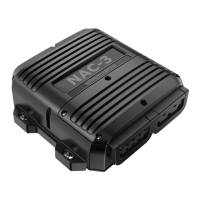• If the vessel has good dynamic stability, a relatively small value
will be sufficient
• An unstable vessel will require high value
• The greater the vessel’s inertia, the greater value will be required
Increasing counter rudder value may result in some higher rudder
activity also when steering a straight course, particularly in high
waves.
The best way of checking the value of the Counter rudder setting is
when making turns. The figures illustrate the effects of various
Counter Rudder settings.
A Counter rudder value too low; overshoot response
B Counter rudder value is too high; sluggish and creeping
response
C Correct setting of Counter rudder; ideal response
Perform various course changes and observe how the boat settles
on the new heading. Start with small changes, 10-20 degrees, and
proceed with bigger changes, 60-90 degrees. Adjust Counter rudder
value to obtain best possible response as in illustration C.
Ú
Note: As many boats turns differently to port versus starboard
(due to propeller rotation direction), do the course changes in
both directions. You may end up with a compromise setting of
Counter rudder that gives a little overshoot to one side and a
bit creeping response to the other.
22
Sea trial | NAC-2/NAC-3 Commissioning Manual

